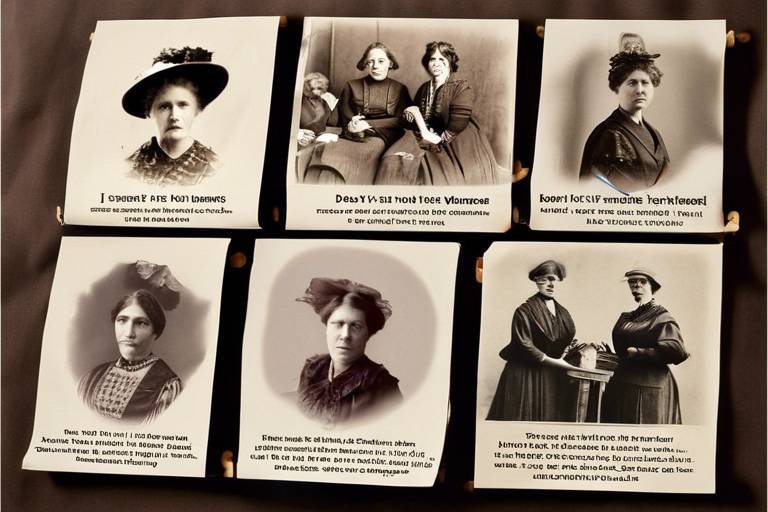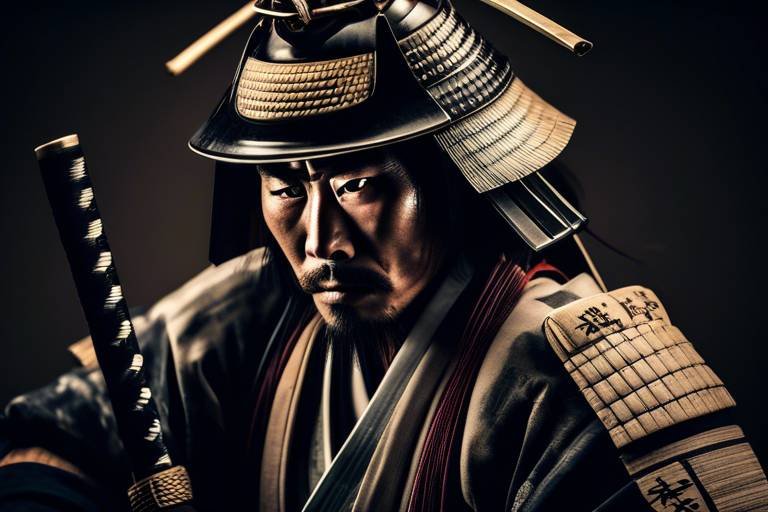The History of the Suffragette Movement - Key Figures
Exploring the significant individuals who played pivotal roles in the suffragette movement, shaping the fight for women's right to vote and gender equality.
Emmeline Pankhurst, the leader of the British suffragette movement, was a force to be reckoned with. Her unwavering determination and fierce activism inspired women across the nation to stand up for their rights. Pankhurst organized protests, hunger strikes, and campaigns, making her a central figure in the fight for women's suffrage.
Susan B. Anthony, a prominent American suffragette, dedicated her life to advocating for women's rights and suffrage. Her relentless efforts in the United States paved the way for future generations of women to have a voice in the democratic process.
Alice Paul, an American suffragette and women's rights activist, was a driving force behind the passage of the 19th Amendment. Her strategic approach to advocacy and nonviolent protest tactics were instrumental in securing women the right to vote.
Emily Davison, an English suffragette, made headlines with her radical activism and unwavering commitment to the cause. Her tragic sacrifice at the Epsom Derby brought international attention to the suffragette movement and the fight for equality.
Lucy Stone, an early American suffragette and abolitionist, was a trailblazer in the fight for women's rights. Her eloquent speeches and advocacy for suffrage and equality laid the groundwork for future generations of women activists.
Ida B. Wells, an African American suffragette and civil rights activist, fearlessly fought against racial and gender discrimination. Her tireless efforts to advocate for women's suffrage and equality left a lasting impact on the suffragette movement.
Christabel Pankhurst, a British suffragette and co-founder of the Women's Social and Political Union, played a crucial role in the suffragette movement in the UK. Her strategic leadership and bold actions were instrumental in advancing the cause of women's suffrage.
Carrie Chapman Catt, an American suffragette and women's rights leader, was a driving force behind the Nineteenth Amendment. Her organizational skills and strategic advocacy efforts were pivotal in securing women's right to vote in the United States.
Sojourner Truth, an African American suffragette and women's rights activist, fought passionately for both women's suffrage and the abolition of slavery. Her powerful speeches and advocacy work inspired generations of women to fight for their rights.
Q: Who was the leader of the British suffragette movement?
A: The leader of the British suffragette movement was Emmeline Pankhurst, known for her activism and role in organizing protests for women's suffrage.
Q: Which American suffragette played a crucial role in the women's suffrage movement?
A: Susan B. Anthony was a prominent American suffragette who played a crucial role in advocating for women's suffrage in the United States.
Q: What was Alice Paul's contribution to the suffragette movement?
A: Alice Paul was instrumental in the passage of the 19th Amendment, granting women the right to vote in the United States.

Emmeline Pankhurst
Emmeline Pankhurst, a name that resonates with courage and determination in the history of the suffragette movement. As the leader of the British suffragette movement, Emmeline was a force to be reckoned with, spearheading the fight for women's right to vote and gender equality.
Her unwavering commitment to the cause led her to organize protests, rallies, and campaigns, all aimed at challenging the status quo and demanding equal rights for women. Emmeline's fiery speeches and bold actions inspired countless women to join the movement and raise their voices against injustice.
Despite facing opposition and backlash, Emmeline remained steadfast in her mission, refusing to back down until women were granted the right to participate in the democratic process. Her relentless pursuit of equality paved the way for future generations of women to assert their rights and claim their place in society.
Emmeline Pankhurst's legacy continues to inspire activists and advocates around the world, reminding us of the power of perseverance and the importance of standing up for what is right. Her contributions to the suffragette movement have left an indelible mark on history, shaping the path towards a more equitable and inclusive society for all.

Susan B. Anthony
Susan B. Anthony, a prominent American suffragette and social reformer, is widely recognized for her significant contributions to the women's suffrage movement in the United States. Born in 1820, Anthony dedicated her life to advocating for women's rights, including the right to vote. She played a crucial role in organizing campaigns, speeches, and petitions to promote gender equality and expand women's political participation.
Anthony co-founded the National Woman Suffrage Association with Elizabeth Cady Stanton, aiming to secure voting rights for women through a constitutional amendment. She tirelessly traveled across the country, delivering powerful speeches and mobilizing support for the suffrage cause. Anthony's unwavering commitment and determination inspired generations of women to join the fight for equality.
Despite facing numerous challenges and opposition, Susan B. Anthony remained steadfast in her pursuit of justice and equal rights for women. She believed in the fundamental principle of equality and tirelessly worked towards creating a more just society where women had a voice in shaping their future.
One of Anthony's most notable acts of protest was in 1872 when she was arrested for voting in the presidential election, challenging the laws that denied women the right to participate in the electoral process. Her trial and subsequent conviction sparked national attention and further fueled the suffrage movement's momentum.
Throughout her life, Susan B. Anthony remained a trailblazer and a symbol of resilience in the fight for women's rights. Her legacy continues to inspire activists and advocates worldwide to keep pushing for gender equality and social justice.

Alice Paul
Exploring the significant individuals who played pivotal roles in the suffragette movement, shaping the fight for women's right to vote and gender equality.
Alice Paul was an American suffragette and women's rights activist who made a lasting impact on the women's suffrage movement. Born in 1885, she dedicated her life to advocating for women's rights and played a crucial role in the passage of the 19th Amendment, which granted women the right to vote in the United States.
Paul was known for her fearless and determined approach to activism. She organized bold and innovative protests, including picketing the White House and going on hunger strikes to demand political rights for women. Her unwavering commitment to the cause inspired many and brought significant attention to the suffragette movement.
One of Paul's most notable achievements was the drafting of the Equal Rights Amendment (ERA) in 1923, which aimed to guarantee equal rights for all citizens regardless of gender. Although the ERA has not yet been ratified, Paul's pioneering work laid the foundation for future generations of feminists and activists.
Throughout her life, Alice Paul remained a steadfast advocate for gender equality, continuing to fight for women's rights until her passing in 1977. Her legacy as a trailblazer in the suffragette movement endures, serving as a beacon of inspiration for those who continue the fight for equality today.

Emily Davison
Exploring the significant individuals who played pivotal roles in the suffragette movement, shaping the fight for women's right to vote and gender equality.
Emily Davison, an English suffragette, is remembered for her radical activism in the fight for women's suffrage. One of her most infamous acts was during the Epsom Derby in 1913, where she stepped onto the racetrack and was tragically struck by the King's horse. This bold and daring act brought attention to the suffragette cause, although it cost her life. Davison's unwavering dedication and sacrifice symbolize the fierce determination of suffragettes in their pursuit of equality.

Lucy Stone
Lucy Stone was an early American suffragette and abolitionist who made significant contributions to the women's rights movement. She was a steadfast advocate for women's suffrage and gender equality, believing in the importance of women's voices in shaping society. Stone's dedication to the cause was unwavering, and she played a key role in advancing the fight for women's rights in the United States.
One of Stone's notable achievements was being the first woman in Massachusetts to earn a college degree. This accomplishment was groundbreaking at a time when higher education for women was not widely supported. Stone's education empowered her to become a powerful voice for women's rights, using her knowledge and eloquence to advocate for equality.
Stone was also a pioneer in advocating for women's right to own property and retain their earnings. She believed that economic independence was crucial for women to have autonomy and agency in their lives. Stone's efforts in promoting economic equality laid the foundation for future generations of women to have greater financial independence.
Additionally, Stone was a strong proponent of women's suffrage, believing that political empowerment was essential for achieving gender equality. She co-founded the American Woman Suffrage Association, a key organization in the fight for women's right to vote. Stone's advocacy and leadership were instrumental in advancing the suffragette movement in the United States.
Throughout her life, Lucy Stone remained dedicated to the cause of women's rights, inspiring others to join the fight for gender equality. Her legacy continues to resonate today, reminding us of the importance of perseverance and determination in the pursuit of social justice.

Ida B. Wells
Ida B. Wells was a remarkable African American suffragette, journalist, and civil rights activist who dedicated her life to fighting against racial and gender discrimination. Born into slavery in Mississippi in 1862, Wells became a leading voice in the campaign for women's suffrage and civil rights in the United States.
Known for her fearless advocacy, Wells co-founded the National Association for the Advancement of Colored People (NAACP) and the National Association of Colored Women. She used her platform as a journalist to expose the horrors of lynching in the South and to advocate for social justice and equality.
Wells' unwavering commitment to justice and equality made her a powerful force in the suffragette movement. She tirelessly fought against the disenfranchisement of African American women and worked to ensure that all women had the right to vote.
Her legacy continues to inspire generations of activists and advocates for social change. Wells' courage and determination in the face of adversity serve as a reminder of the power of one individual to make a difference in the fight for equality and justice.

Christabel Pankhurst
Exploring the significant individuals who played pivotal roles in the suffragette movement, shaping the fight for women's right to vote and gender equality.
Christabel Pankhurst was a British suffragette and co-founder of the Women's Social and Political Union. Born in 1880, she played a vital role in the suffragette movement in the UK, advocating for women's right to vote and actively participating in protests and campaigns for suffrage.
Known for her fierce determination and strategic leadership, Christabel was instrumental in organizing militant tactics to draw attention to the cause of women's suffrage. She believed in direct action and civil disobedience as effective means to bring about change and challenge the existing societal norms.
Christabel's dedication to the suffragette movement led to her arrest multiple times, but she remained steadfast in her commitment to achieving equality for women. Her bold and unapologetic approach inspired many others to join the fight for suffrage and paved the way for future generations of women activists.
Despite facing opposition and criticism, Christabel Pankhurst continued to be a prominent figure in the suffragette movement, using her voice to demand justice and equal rights for women. Her legacy as a fearless advocate for women's suffrage remains an integral part of the history of the fight for gender equality.
- Q: Who were the suffragettes?
- Q: What was the suffragette movement?
- Q: Why was the suffragette movement important?
A: The suffragettes were members of women's organizations in the late 19th and early 20th centuries who advocated for women's right to vote through direct action and civil disobedience.
A: The suffragette movement was a social and political campaign that aimed to secure voting rights for women, challenging the traditional gender roles and advocating for gender equality.
A: The suffragette movement was crucial in advancing women's rights and paving the way for gender equality. It brought attention to the unequal treatment of women in society and led to significant changes in legislation granting women the right to vote.

Carrie Chapman Catt
Exploring the significant individuals who played pivotal roles in the suffragette movement, shaping the fight for women's right to vote and gender equality.
Carrie Chapman Catt was a prominent American suffragette and women's rights leader who made significant contributions to the women's suffrage movement. Born in 1859, Catt dedicated her life to advocating for women's rights and played a crucial role in the passage of the Nineteenth Amendment, which granted women the right to vote in the United States.
Known for her strategic approach and leadership skills, Catt served as the president of the National American Woman Suffrage Association and played a key role in orchestrating the successful campaign for women's suffrage. She was a tireless advocate for women's rights, traveling extensively to promote the cause and build support for the suffragette movement.
Carrie Chapman Catt's efforts were instrumental in advancing the women's suffrage movement in the United States, and her legacy continues to inspire future generations of activists fighting for gender equality and social justice.

Sojourner Truth
Sojourner Truth, an African American suffragette and women's rights activist, was a remarkable figure in the fight for gender equality and the abolition of slavery in the United States. Born into slavery, she escaped to freedom and became a powerful advocate for the rights of both women and African Americans. Truth's famous speech "Ain't I a Woman?" delivered at the Women's Rights Convention in 1851 highlighted the intersectionality of race and gender in the struggle for equality. She fearlessly challenged societal norms and fought against discrimination, emphasizing the importance of equal rights for all individuals regardless of race or gender.
Throughout her life, Sojourner Truth traveled extensively, spreading her message of equality and justice. She engaged in public speaking, sharing her experiences as a former slave and advocating for the rights of marginalized communities. Truth's commitment to social reform and her passionate advocacy for women's suffrage inspired generations of activists to continue the fight for equality and justice.
Sojourner Truth's legacy continues to resonate today, reminding us of the power of courage and resilience in the face of adversity. Her tireless efforts to challenge injustice and inequality serve as a beacon of hope and inspiration for those striving to create a more just and equitable society.
Frequently Asked Questions
- Who were the suffragettes?
The suffragettes were members of women's organizations in the late 19th and early 20th centuries who advocated for women's right to vote and gender equality. They were part of the larger suffrage movement that fought for women's political rights.
- What was the suffragette movement?
The suffragette movement was a social and political campaign that aimed to secure voting rights for women. It involved various forms of activism, such as protests, demonstrations, and civil disobedience, to bring attention to the cause of women's suffrage.
- Why was the suffragette movement important?
The suffragette movement was important because it paved the way for women to have a voice in the political process and participate in shaping the laws and policies that affect their lives. It was a significant step towards achieving gender equality and challenging traditional societal norms.
- What were some key achievements of the suffragette movement?
Some key achievements of the suffragette movement include the passage of the 19th Amendment in the United States, granting women the right to vote, and the increased awareness and support for women's rights and gender equality on a global scale.



















